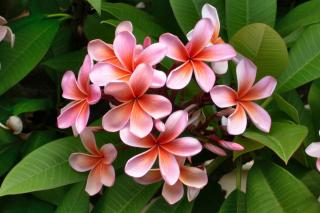

Frangipani is a shrub used indoors for its appealing blooming and its great ornamental qualities. Outdoors, it only grows well in warm climates.
Frangipani facts, a summary
Name – Plumeria
Family – Apocynceae or dogbane
Type – perennial
Height – 5 feet (1.5 meters) indoors, 32 feet (10 meters) in its natural environment
Exposure – full sun or well-lit
Soil – rather rich and well drained
Foliage – semi evergreen
Flowering – summer
Caring for it requires care for watering, location and to avoid diseases.
Indoors, growing frangipani requires rather rich soil: best use a good soil mix.
If you plan to grow frangipani outdoors, wait for spring and choose a sunny spot.
It isn’t really a requirement to prune.
Remove wilted flowers regularly in order to boost flower-bearing and keep the plant from dispensing energy to try preparing fruits.
Frangipani only requires very little water in winter, but needs more regular watering in spring and summer, especially if it’s hot.
That is the most essential need for it to bear flowers. If you can’t water, the tree will survive even long droughts, but it might not bloom as much.
 Frangipani is easygoing and requires very little care.
Frangipani is easygoing and requires very little care.
Indoors, in an apartment, choose a very sunny location, in direct sunlight for the most part of the day.
You can bring it outdoors in summer, from May to September or October, but take care not to transfer it immediately to a scorching location because this could dry the plant up and brutal changes can stress it considerably.
To flower well, frangipani requires a certain change in seasons, marking the dry winter period and the moist summer season.
If you discover cottony white clumps, there is no doubt about it: scale insects.
This parasite appears when the air in the room is too dry and the temperature is high.
It may also happen that the frangipani is faced with rotting when the soil is too moist.
Only water when the soil is dry, and also check that your pot lets excess water drain out away from the roots, it must be well drained and have holes at the bottom.
This is usually the result of overwatering. Roots start rotting and can’t sustain the tree anymore.
 This flower is connected in many cultures to immortality. Indeed, a cut branch can still bear flowers and take root even weeks after having been detached from the tree! It is present in many temples and cemeteries across SouthEast Asia.
This flower is connected in many cultures to immortality. Indeed, a cut branch can still bear flowers and take root even weeks after having been detached from the tree! It is present in many temples and cemeteries across SouthEast Asia.
The scent is sweet and fragrant, strong without being overpowering. A true winner!
Since it also represents eternity, some even select it as a flower to decorate weddings, to reflect on the engagement “till death do us part”. But this is a challenging endeavor because the individual flower only lasts a single day when picked. It requires flawless logistics!
Flowers are edible, and can be used to decorate meals, desserts and mixed salads. They will only last a day, so pick them at the last moment!
Frangipani plant yellowing leaves. What is wrong and what can help the plant regain dark green leaves
Hi Anthony, when planted in the ground, frangipani will lose a few leaves regularly every now and then as it grows new ones. It’s normal, that’s how the plant replaces its leaves. Usually, this happens during dryer seasons. About one or two leaves for every 10 will be turning yellow in the normal course of things.
However, if growing in a pot, usually a major problem is overwatering. This means that roots are always wallowing in soggy soil, and start rotting. As they decline and decay, they can’t send nutrients and water up to the trunk and branches.
Frangipani loves soil that drains very well. If it’s turning yellow all over, perhaps the pot isn’t draining well enough.
– Sometimes the hole underneath is clogged by roots that have grown through it. If this is the case, best is to repot in a slightly larger pot.
– When watering, make sure you empty the saucer that caught excess water instead of letting the pot wallow in it. If the pot is heavy, a better option is to spread gravel or clay pebbles between saucer and pot: that way, the elevated pot drains well and the saucer doesn’t need to be emptied.
– For frangipani, best is to let the soil dry up nearly entirely before watering again. The trunk and stems of the tree act like a reservoir, so it won’t hurt the plant at all if the soil is completely dry for days on end. It’s actually healthier for the roots.
@Steve, yellowing also might de due to pests infecting the tree, you’re right!
yellowing of leaves,also something is eating it.